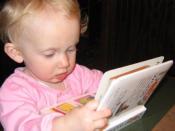�PAGE � �PAGE �2�
The Relationship of Infant Attachment Patterns to Personality Development
�
Purpose
From the previous study, personality development has five perspectives, they are temperament, psychoanalytic, attachment, self and observed behavior, and this study will only focus on attachment perspective. According to Ainsworth (1978, as cited in Cassidy, & Mohr, 2001)'s attachment finding, there are 3 types of attachment: 1) secure attachment; 2) avoidant/insecure attachment; 3) resistant/insecure attachment. Many of the psychologists propose that secure infant attachment. The purpose of the current study was to examine the relationship of infant attachment patterns to their further personality development. 60 infant (30female, 30 male, mean age 4 years) and their caregivers were participated in a longitudinal research study. It was hypothesized that infant attachment would contribute an optimal score in the Big Five personality Questionnaire. Ainsworth's 'strange situation' test was used to predict quality of infant attachment, while Big-Five Questionnaire- Children Version (BFQ-C) was used to examine their personality development.
The aspect result would be strongly support previous theoretical that secure attached infant have been found on average more confident, self-efficacy and more sociable in later childhood than those who were insecurely attached.
�
The concept of personality refers to the profile of stable beliefs, moods, and behaviors that differentiate among children (and adults) who live in a particular society (Kagan). There are inherent natural, genetic, and environmental factors that contribute to the development of our personality. There are five different perceptions regarding to the early origins of personality. They are 1) temperament which assumes the child's inherited biology; 2) Sigmund Freud's Psychoanalytic which assumes conflict over sexual and hostile motives through the interaction of id, ego and superego; 3) Attachment to the caregiver in the infant years; 4) self interpretation of experience; 5) observed behaviour (Kagan). The current research...


